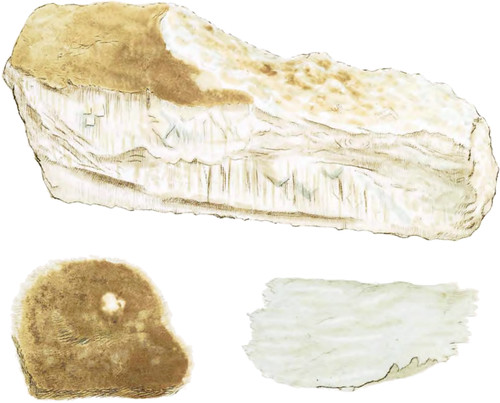 Enlarge
Enlarge
British Mineralogy
Amianthus
- Class 2. Earths.
- Order 1. Homogeneous.
- Gen. 4. Silex.
- Spec. Magnesiatus.
- Div. 2. Imitative.
- Spec. Char. Silex in combination with Magnesia.
- Syn.
- Amianth. Kirw. v. 1. 161. Emmerl. 1. 402. Jameson, 1. 442. Wern.
- Asbestus maturus, Amaianthus. Waller, 1. 408. 410.
- Asbeste. Haüy, 3. 245.
Amianthus is probably a decomposition, or change performed perhaps by some yet unknown chemical agent, as its situations in solid rocks seem to evince. This unknown chemical agent does not appear to be common, as the Amianthus is not an universal substance in the silky filamentous form. The present specimen was undoubtedly chosen with a scientific view by my kind patron Lord Seaforth, who brought it from Portsoy.
It is partly what is called Mountain Cork in a rather dense state, including some very fine transparent Carbonate of Lime, in which there are extremely slender filaments of Amianthus, seemingly passing through it, and in some parts so incorporated with it, that it is not to be discerned where they end or the Carbonate of Lime begins. The filaments run perpendicularly to the more dense or cork-like surface of the upper and lower sides of the specimen, which however has more of a cottony texture, but is much finer than any cotton or vegetable thread: the first seems infinitely fine; the latter may be seen by a microscope to show a finally confirmed hollow filament*. It generally is found in Serpentine rocks.
- * I was highly pleased to find in Mr. Carlisle’s Croonian lecture read to the Royal Society, Nov. 8, 1804, that he had determined the final filament in muscular flesh. I had been much puzzled with the assertion that Lewenhoeck had found them infinitely divisible: having long since taken the pains to examine a piece of mutton flesh, I found the smallest filaments easily discernible, and according with Mr. Carlisle’s accurate account, as far as I examined, but they are not so in Asbestus, or any filamentous earth.

